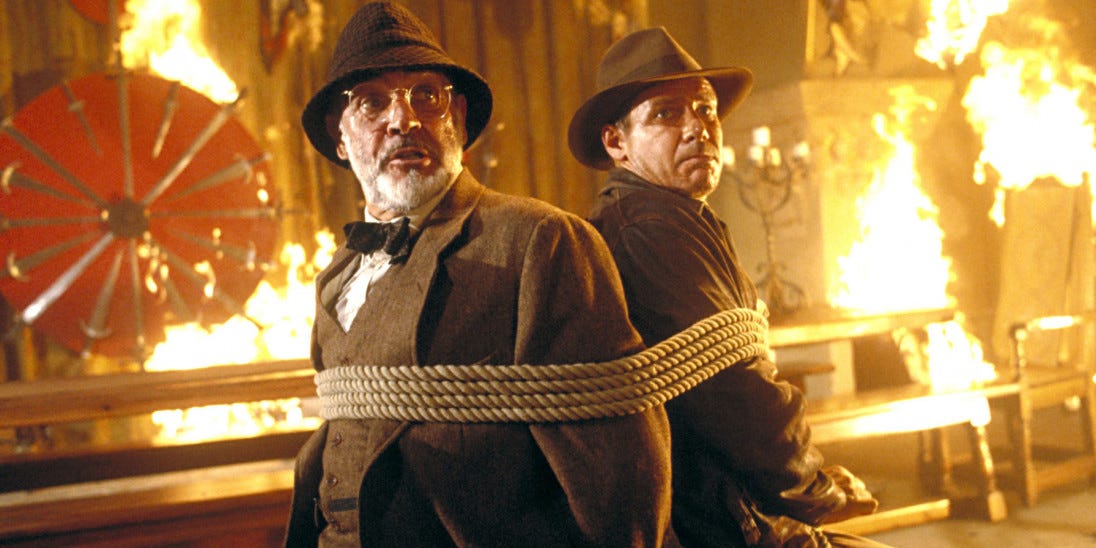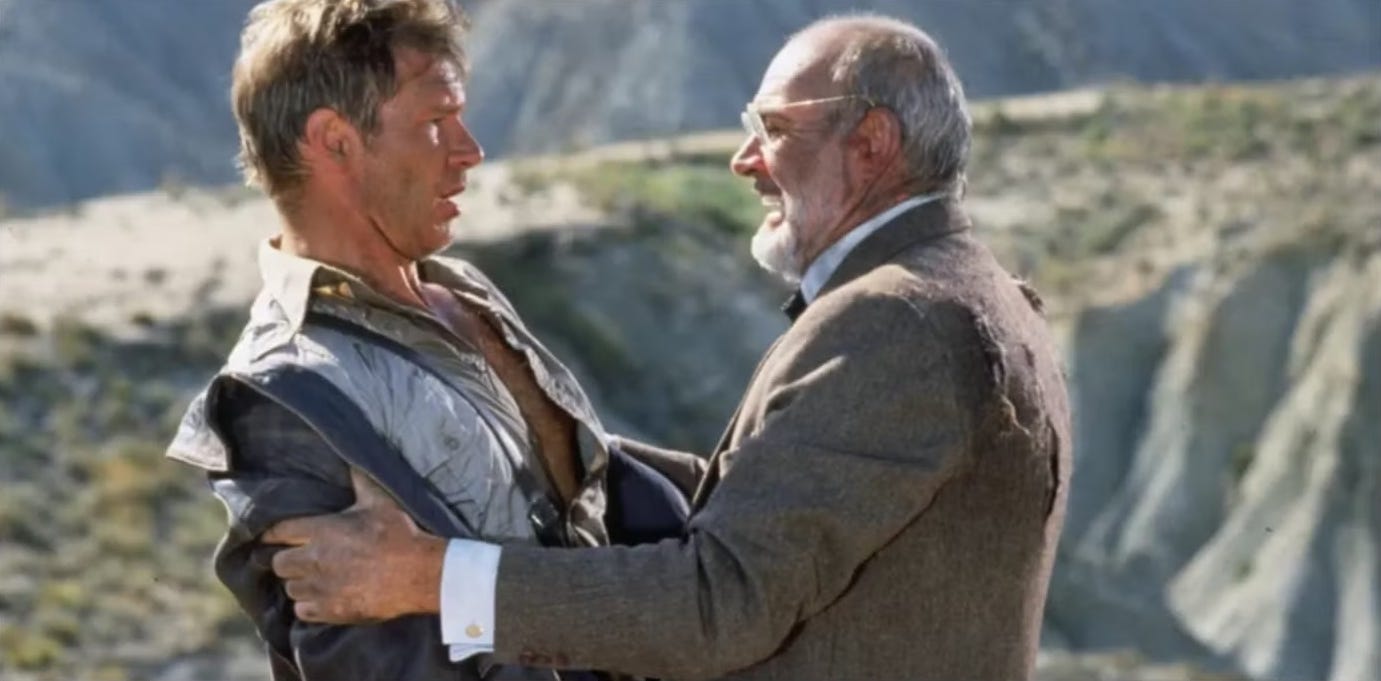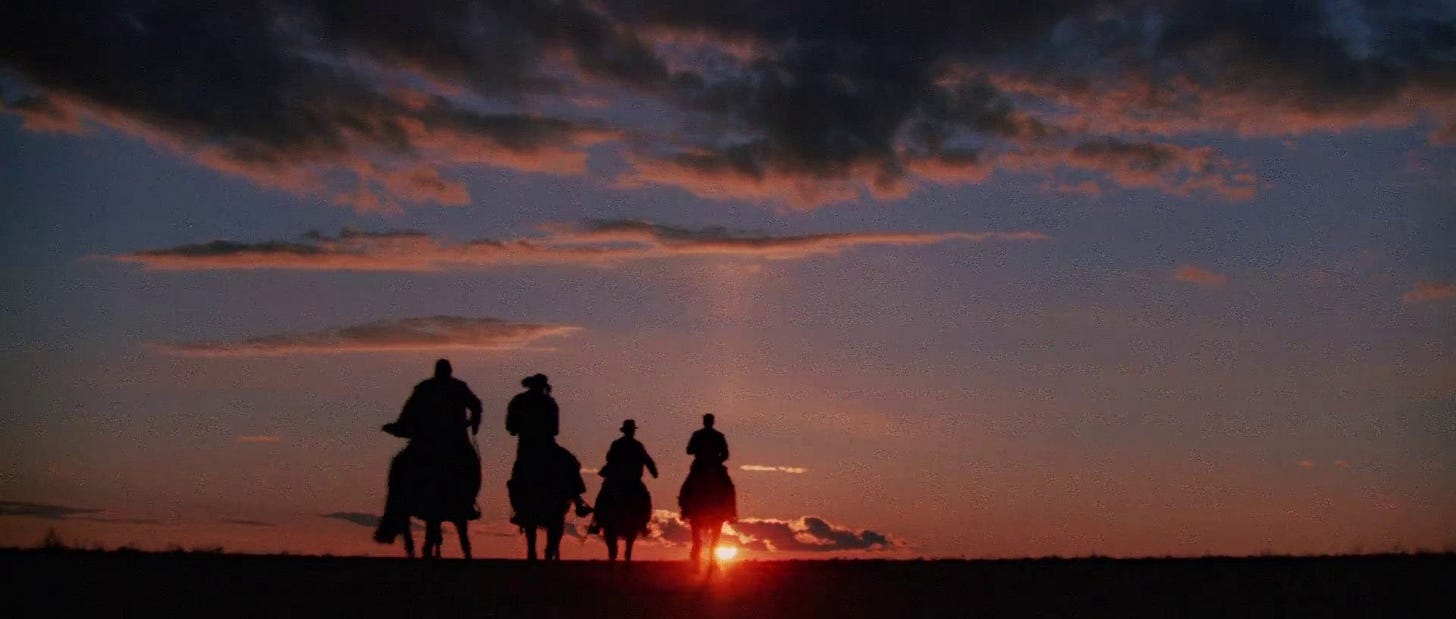The FFFEYIBA Project—1989
ELSA: “Don’t look at me like that. We both wanted the Grail. I would have done anything to get it. You would have done the same.” INDY: “I’m sorry you think so.”
For a quick reminder on the purpose, rules, and account of the acronymous complexity of the project, please see this post.
HM #1: Henry V
I’ve always loved Kenneth Branagh as a director, because his most prominent directorial virtue is one in increasingly short supply in today’s Hollywood: sincerity. It’s why his Cinderella is far-and-away the best of Disney’s (almost-hopelessly-ill-fated) live-action Princess remakes. (Think Mark Webb could have used a bit more sincerity this past weekend?) It’s why, much as I love the wild world-building and bizarre tone of Taika Waititi’s Thor: Ragnarok and chuckle at the sly sarcasm in every Downey (and Jackson and Hiddleston and Evans and Johansson and Ruffalo) line from Joss Whedon’s The Avengers, it’s only Branagh’s Thor (from the first, standalone film) that makes any sense to me as an actual character. But he’s more than just a sincere filmmaker; he’s also such a wonderful filmic ambassador for The Bard, and this work is his most successful offering on that front. A superb mixture of theatrical and cinematic craft, it’s a powerful, fantastically-accessible version of young Hal’s turn from ne’er-do-well to legendary king. The cast (including Branagh) is universally excellent; the contrast between its many dialogue-heavy scenes and its gritty war sequences, surprisingly effective; Derek Jacobi’s Chorus anchors one of the most arresting openings of all time; and the Crispin’s Day Speech, the most vital part of any Henry V production (by which success or failure will always be measured), absolutely unforgettable. (Speaking of those last two points, we must mention the transcendent work of long-time Branagh collaborator, composer Patrick Doyle. This one gets my vote for greatest soundtrack ever—greatest, as distinguished from favorite, actually, yes. I don’t think there’s ever been a more perfect marriage of music and material.)
HM #2: The Killer
John Woo is a man who has fun making films; you can see it in every blood-soaked, slo-mo frame of his Hong King action extravaganzas. And while this particular offering is not the first or most enjoyable of his works that I saw—that “honor” goes to Hard Boiled, on both counts—it still sticks in my mind, even to this day. It doesn’t have quite the razzmatazz of Hard Boiled (whose Hospital Shootout Oner is both legendary and yet, somehow, still less appreciated than it deserves), but the emotional power is unquestionably there. Over at the Criterion Collection’s site, oft-frequented by me when I’m putting these posts together, David Chute calls it “one of the most passionate and exhilarating gangster movies ever made,” and I’m inclined to agree. HM: Woo eventually remade it, releasing an English version just last year. While I mildly prefer allowing original directors to do their own English remakes over bringing in someone new (as I mentioned last week), I can’t see a single reason for remaking this one. Yes, I realize that the remake was in the works as early as 1992, and I like Omar Sy as much as the next person (perhaps even a bit more). But the original’s perfectly brilliant “as is.” Do we really need another?
HM #3: Violent Cop
Takeshi “Beat” Kitano is also a man who has obvious fun making films. The films themselves are quite a bit less fun than Woo’s, though. That’s not a criticism, of course, but a reality. Originally written as a comedy (which would make sense of Kitano’s involvement, given his then-legendary status as a comedian), the end result (mostly rewritten by Kitano himself) is anything but a comedy. Described in some places as a “hyper-violent neo-noir”—a beloved genre of mine, to be honest—and in others as a “stark, nihilistic action thriller,” it is above all a film that heralds the arrival of an unusual (and note-worthy) cinematic voice. It falls a bit below Hana-bi and Sonatine, in my estimation, but is another for my growing list of “First-time films that are supremely confident and whose directors seem fully-formed from the get-go.” There’s something strangely fascinating and unexpected about Kitano’s work, and I can’t help but wonder if it’s the bizarre combination of “hyper-violent, nihilistic action” material with a man who has spent the vast majority of his (public) life making people laugh.
And now, to the main event…
1984’s Selection: Indiana Jones and the Last Crusade, by Steven Spielberg
What a relief. After back-to-back-to-back weeks of European arthouse fare, I was beginning to wonder if I was, in fact, more of a film snob than a film lover. And then, the perfect Kettle Corn Movie comes along and saves me from such self-censure. …for the time being, at least.
Why “kettle corn?” Because it’s the perfect mixture of sweet and salty. Of action and reflection. Of meat and bonbons. Of substance and spectacle.
In fact, it’s the perfect Indy film.
Yes, Raiders of the Lost Ark is great. Spielberg’s eye for action and for the staging of unmatched, unforgettable, unbeatable set pieces is without equal. No one combines old-timey film sensibilities with modern-day technical abilities the way he does, and it’s always a real joy to watch. To quote Steven Soderberg (from an earlier post in this series), “this filmmaker forgot more about staging by the time he made his first feature than I know to this day.” But still, as I also said in that earlier post (and in the very first thing I wrote publicly about this series, over eight years ago, so at least I’m consistent, even if I am crazy), “I can’t quite get my heart to leap as high when I’m watching the Original Indy Film as others’ devotion would suggest it should.” There’s something a bit too dour about it all; a bit too grim; the stakes, a bit too existential and Old-Testament-ish. I guess I’d say “it’s a great beginning, but one that I respect, rather than love; needs a little more heart, a little more humor, a little more grace.”
And that heart shows up in one of the my very favorite examples of on-screen chemistry ever: Harrison Ford and Sean Connery.
Jeffrey Boam’s script is a bit longer than Lawrence Kasdan’s work on the original film, but it doesn’t feel over-stuffed, nor does it drag. And that extra length is precisely what allows for the charming, often-humorous, always-illuminating exchanges that flesh out the relationship between Ford and Connery. Since that’s precisely what sets the two films apart (in my estimation, at least)—“I suddenly remembered my Charlemagne.”—the running time seems like a small price to pay.
But lest one be misled into thinking that it’s a much “talkier” film than the original, let me hasten to add that it’s also filled with its own litany of astonishing set pieces: feeling through Venice by motorboat, with the Brotherhood of the Cruciform Sword in hot pursuit; the night imprisonment and escape from Castle Brunwald (which contains my favorite moment of “humor through physical action” in the entire series); jousting on motorcycles; battling the tank from horseback (which feels like this film’s homage to the legendary Truck Chase in Raiders); the zeppelin flight from Berlin to Athens (that leads straight into the biplane chase); the masterful Path, Word, and Breath of God sequence before the final reveal. And, of course, the moment where he comes face-to-face with Hitler! …and gets his autography. (Speaking of Hitler and of great bit parts, Michael Byrne’s General Vogel is one of the very best.)
Lest I bury the lede, though, I should highlight what I consider to be the most important and most carefully-choreographed action sequence of the entire film: the opening prologue, which explains so much of Indy’s mythology. (It also allows Spielberg to shoot in Arches National Park, making the opening of the film a clear homage to the Westerns of John Ford, just like the film’s final shot.)
All this talk of the film’s excellence makes me anxious to watch it again as soon as possible. Which is the fundamental point of this exercise, right? Favorites are the best.
As usually, I can’t let this one go without mentioning the music, once again. John Williams, the Master. The entire score is brilliant. For the more musically interested (or, if you’re me, obsessed), while it might not feature the most famous cut from the series—that’s surely the “Raiders March”—it does include what I consider the finest bit of music: the Grail Theme, embedded in “The Keeper of the Grail” and the “Finale & End Credits.” In that last track, it comes straight out of the Indy theme, showing that all the swashbuckling adventuring leads to a moment of seriousness and of real choice. And in that moment, Indy (guided by his father), chooses faith. The perfect musical representation of the film’s point.
Honorable Musical Mention: The Grail theme also appears at the tail end of “Indy’s Very First Adventure,” yet another example of the way the film’s prologue sets up so many of the story’s future events and so much of the film’s conflicts and themes. (Speaking of that gorgeous Grail motif, I feel compelled to point out just how much it sounds like a “swords-and-sandals” theme from Classic Hollywood. No accidental similarity, surely. And I feel also compelled to point out the cut on the soundtrack entitled “Scherzo for Motorcycle and Orchestra.” That title alone is enough to earn it legendary status in my book.)
Honorable Final Thought: I said that I found the first one too dour and too grimly Old-Testamental for my tastes, and I think that’s best illustrated by the power of the film’s central artifact, the Ark of the Covenant. It destroys anyone who dares to look upon its glories—horrifyingly and (as far as we can tell) indiscriminately—and the only way to avoid its avenging wrath is to look away, and pray for mercy. For the Nazi armies (and for the purpose of the film), it’s an apocalyptic weapon, pure-and-simple. The Holy Grail, on the other hand, gives life and hope; it heals, rather than destroys. Those who seek to abuse it are punished for their greed, but not by the artifact itself. And I think that shift makes all the difference.









I agree with nearly everything you wrote about IJATLC, and your comparison of it to Raiders. I liked your point at the end as well, regarding the two artifacts. Let me add two points/opinions.
One element of both films that lend to their fun and adventure is the change of locales. Neither movie is static (one reason why Temple of Doom pales in comparison). Exotic locations, cities, and milieus adds to the excitement and scale.
Point two re: set pieces. I gotta give the nod to Raiders, if solely for the Nepalese tavern fight - including his reunion with Marion. So much said with so little dialogue. Best brawl (with a clever plot point hidden in plain sight) bar none. And yes, I intended that pun.
Honorable mention: the Cairo market fight scene is also perfect - most iconic improvisational scene ever, in my estimsation.